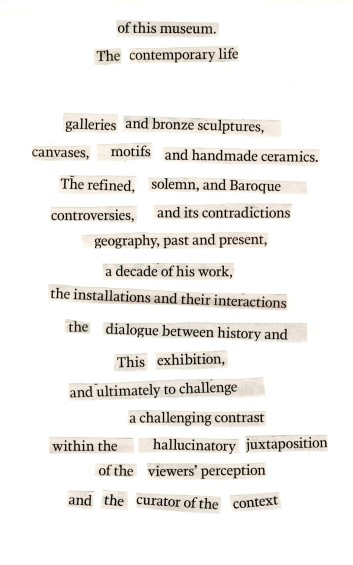To create is to destroy.
In the making of this poem, in which I use a museum as an analogy for life, I destroyed a brief introduction to a Sterling Ruby’s exhibition at the Gagosian gallery. The purpose of this exercise was to engage myself with an editing method that David Bowie himself used to create his magnificent lyrics – the cut-up technique.
The cut-up technique consists of an aleatory literary approach in which an existing text is literally cut up into little bits and rearranged to create a new piece of writing.
The concept can be traced back to the poet Tristan Tzara and the Dadaists of the 1920s. However, it wasn’t until the decades of the 1950s and 1960s that it became widely popularised by the writer William S. Burroughs, author of The Third Mind. Since then, this method has been used in a great variety of contexts.
Although collage was the dominant form in the arts for much of the 20th century, it wasn’t until after World War II that it really took hold in literature and music. The man who almost single-handedly transformed the former and ultimately influenced the latter was author William S. Burroughs (1914-1997), a pioneer of the cut-up technique, a method of cutting up pre-existing media and rearranging it to form something entirely new. (Pallanck, 2005)
Revolutionising not only literature but also music (songwriting) and visual arts, the cut-ups acted as a breakthrough to the traditional way of producing content.
Burroughs found it interesting how the source material’s style remained intact after being processed and, furthermore, that the seemingly chaotic reordering of words, sounds and images that a cut-up yielded was similar to human experiences (…) “Consciousness is [always] being cut up by random factors,” Burroughs noted. “Life is a cut-up, not a nonlinear narrative.” (Pallanck, 2005)
However, one very important question arose: Where do we draw the line between cut-ups and plagiarism? When does rearranging someone else’s words becomes authorship theft?
Edward S. Robinson questioned himself just that. He developed an interest in the works of writer Kathy Acker and the effect Burroughs’ writings and ideas had on her practice. He writes (2011): “Although many writers have cited Burroughs as an influence, few have followed his lead to the extent that Kathy Acker has. (…) Acker often wrote using methods derived from Burroughs, taking The Third Mind as her inspiration. (…) Acker herself described how she used The Third Mind as experiments to teach herself how to write.”
He analysed the use of the cut-up technique by Acker, explored the significant influence of the writings and ideas of William S. Burroughs on her works and discussed how Acker moved away from the cut-up approach into a so-called copy-paste collage method, expanding the principles of the technique to include notions of plagiarism and intellectual ownership.
Living in the digital era, we no longer need scissors to make cut-ups. We have access to almost all the books we could ever need and texts and articles from newspapers and magazines are merely a click away.
The cut-up technique – or rather a version of it – , even if unconsciously, has become ordinary, a common use when typing our word documents.
It is thus, more than ever, necessary to be conscious, take a step back, and analyse how we use the words we can so easily copy from the Internet, this huge virtual library with no members’ fee.
As easy as it is to create something by copy-pasting from a variety of sources, do you really want to call it a creation of your own?
Bibliography:
- PALLANCK, L., 2005. WILLIAM S. BURROUGHS. Remix, 7(3), pp. 130.
- Robinson, E. (2011). Shift linguals. 1st ed. Amsterdam: Rodopi.


Reblogged this on Writing as Practice and commented:
The cut-up technique consists of an aleatory literary approach in which an existing text is literally cut up into little bits and rearranged to create a new piece of writing.
LikeLike
Reblogged this on CTS at LCC.
LikeLike